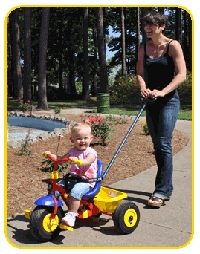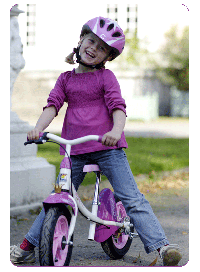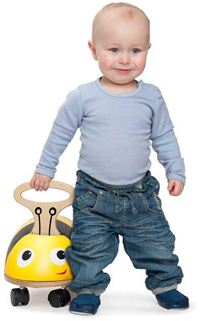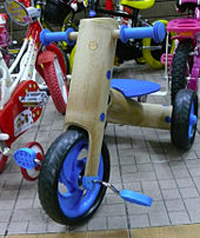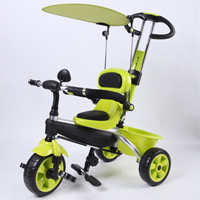
Why to Choose
| Tricycles are typically used by children between the ages of two and four, after which point they usually switch to a bicycle, often with training wheels. Parents choosing a tricycle for their child should ensure that the trike is not too tall and that the seat is too high, and that the wheelbase is wide enough, because if this is not the case, the child may tip over easily. The seat should be stable, which is not always the case with the most inexpensive models. Some trikes have back rests which provide support and a push bar for parents so that the parents can push the child up hills or hold the child back when descending, or in case of the sudden approach of other traffic. For safety many parents make children wear a helmet when riding a trike. Some parents also attach a safety flag to the trike so that the child will be more visible to drivers. | |
Structure
| | Children's trikes are made of steel frames or plastic. One disadvantage of plastic frames is that they are more likely to tip over than a steel frame if a heavier child is riding. On the plus side, plastic frames will not rust like steel frames if the trike is left out in the rain. Children's tricycles can also be made from bamboo. Bamboo has a tensile strength that is comparable to steel while at the same time being lightweight like a plastic frame. Bamboo can also be used to make an adult bamboo bicycle. While most children's trikes have direct drive, a small number of models such as the Cheetah have chain drive. Unlike adult bikes, children's trikes do not always have pneumatic tires; instead, some trikes have solid rubber wheels. While this adds to the weight of the tricycle and reduces the shock-absorbing qualities, it eliminates issues with flat tires, punctures, and leaky tubes. Since most trikes are direct drive, the child can slow the trike down by resisting the forward motion of the pedals, as with an adult fixed gear bike. |
Pull brakes are rarely used on children's trikes, but some "Bigwheel"-style plastic trikes have lever brakes in which an inverted half-moon-shaped brake pad is pressed against the driving surface of the right rear wheel.
Getting Started
| As parents we are always eager for our children to move ahead, but rushing the learning process might turn a rewarding experience into a frustrating one. Start with the age, size and physical development of your child. Try to be objective and choose tricycles and ride on toys that are an honest reflection of your toddlers or preschoolers ability. Other things to keep in mind
| |
Away we go!
First ride on toys without pedals, such as the Bee Roller Ride-On from Skipper by Kettler, give toddlers and preschoolers a brand new sense of mobility and independence. Learning to steer and push with both feet strengthens leg and hip muscles and builds coordination.
Keep it safe. Make sure they are on a flat, smooth surface - away from possible dangers such as stairs or curbs.
Ready to Pedal
Tricycles provide a safe, secure vehicle for learning to pedal. It is not an overnight thing and it may take some time for your toddler or preschooler to master. Key to success is choosing the right trike. Fit the tricycle to the child. Kids must be able to position their weight over the pedals comfortably in order to push properly.
| | Tricycles with multiple frame and seat adjustments will make this a sure thing.
|
What? No Pedals?
| Balance Bikes are toddler sized bicycles without pedals or gears. They are designed to help children learn to balance without the complication of pedals and to transition directly to a bicycle with ease and at an earlier age. First invented in Europe, the success of Balance Bikes there has shown that children between the ages of two and three years will naturally learn to balance for short times, through a combination of pushing and lifting of their feet. As they become surer of their ability, they balance for longer and longer times. Children feel secure to practise because they can always put their feet down to either steady themselves or stop. | |
How do they work?
Young children naturally learn to both pedal and balance. But not usually at the same time!
Separating these two skills makes each of them easier to master. To begin with balancing makes sense, as it is the more difficult of the two.
With the big hurdle of learning to balance out of the way, when children are ready to transition to a bicycle, they are free to focus all of their attention on pedalling. It then comes quickly - and without training wheels!
Written by Nicolas Yang
